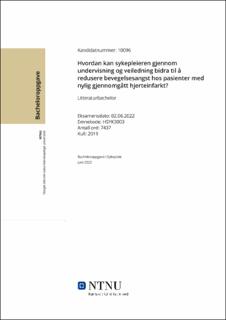| dc.contributor.advisor | Ernsten, Linda | |
| dc.contributor.author | Sørensen, Tarjei Sollie | |
| dc.date.accessioned | 2022-07-19T17:20:23Z | |
| dc.date.available | 2022-07-19T17:20:23Z | |
| dc.date.issued | 2022 | |
| dc.identifier | no.ntnu:inspera:110921428:36273847 | |
| dc.identifier.uri | https://hdl.handle.net/11250/3006921 | |
| dc.description.abstract | Bakgrunn: Det å bli innlagt på sykehus med hjerteinfarkt oppfattes av de fleste pasienter som skremmende og livstruende. Utgangspunktet for valg av tema var egne erfaringer fra klinisk praksis da jeg erfarte at noen av pasientene vegret seg for bevegelse og fysisk aktivitet selv om de var behandlet og klar for utskrivning. Dette er uheldig ettersom fysisk aktivitet betraktes som et sentralt sekundærforebyggende tiltak.
Hensikt: Å finne kunnskapsbasert støtte for at sykepleiere kan øke pasientens forståelse av egen situasjon gjennom undervisning og veiledning og at bekymringen for bevegelse og fysisk aktivitet etter nylig gjennomgått hjerteinfarkt reduseres.
Metode: Det ble gjennomført strukturerte litteratursøk på databasene Cinahl og Pubmed, hvor 7 relevante artikler ble tatt med i oppgaven. I tillegg ble det gjennomført håndsøk hvor 2 artikler ble inkludert. Det ble benyttet totalt 9 forskningsartikler.
Resultat: Forskningslitteraturen viste at bevegelsesangst i etterkant av hjerteinfarkt var å finne hos en stor andel av pasientene som deltok i de ulike studiene. I tillegg viste flere av artiklene at pasientene som opplevde bevegelsesangst følte seg dårlig informert av helsepersonellet. Attpåtil viste noen av artiklene at bevegelsesangst reduserte deltagelsen på hjerterehabilitering.
Konklusjon: Litteraturen viser at sykepleieren gjennom adekvat kommunikasjon og informasjon, samtidig som sykepleieren er bevisst sin rolle som veileder, kan veilede pasientene i å velge strategier som fremmer mestring og reduserer bevegelsesangst etter gjennomgått hjerteinfarkt.
Nøkkelord: Kinesiophobia, bevegelsesangst, undervisning, veiledning, hjerteinfarkt | |
| dc.description.abstract | Background: Being admitted to a hospital with a heart attack is perceived by most patients as frightening and life-threatening. The reason I chose the following topic was based on my own experiences from clinical practice when I experienced that some of the patients avoided early mobilization and physical activity even though they were ready for discharge. This is unfortunate as physical activity is considered a key secondary preventive measure.
Aim: Finding knowledge-based support so that nurses can increase the patient's understanding of their own situation through teaching and guidance and that the concern for movement and physical activity after a recent heart attack is reduced.
Method: Structured literature searches were performed on the databases Cinahl and Pubmed, where 7 relevant articles were included in this thesis. In addition, a hand search was conducted where 2 articles were included. A total of 9 research articles were used.
Results: The research literature showed that movement anxiety after a heart attack was found in a large proportion of the patients who participated in various studies. In addition, several articles showed that patients who experienced movement anxiety felt poorly informed by healthcare professionals. additionally, some of the articles showed that movement anxiety reduced participation in cardiac rehabilitation.
Conclusion: The literature shows that the nurse, through adequate communication and information, at the same time as the nurse is aware of her role as a supervisor, can guide patients in choosing strategies that promote coping and reduce movement anxiety after a heart attack
Keywords: Kinesiophobia, movement anxiety, teaching, guidance, heart attack | |
| dc.language | nob | |
| dc.publisher | NTNU | |
| dc.title | Hvordan kan sykepleieren gjennom undervisning og veiledning bidra til å redusere bevegelsesangst hos pasienter med nylig gjennomgått hjerteinfarkt? | |
| dc.type | Bachelor thesis | |
